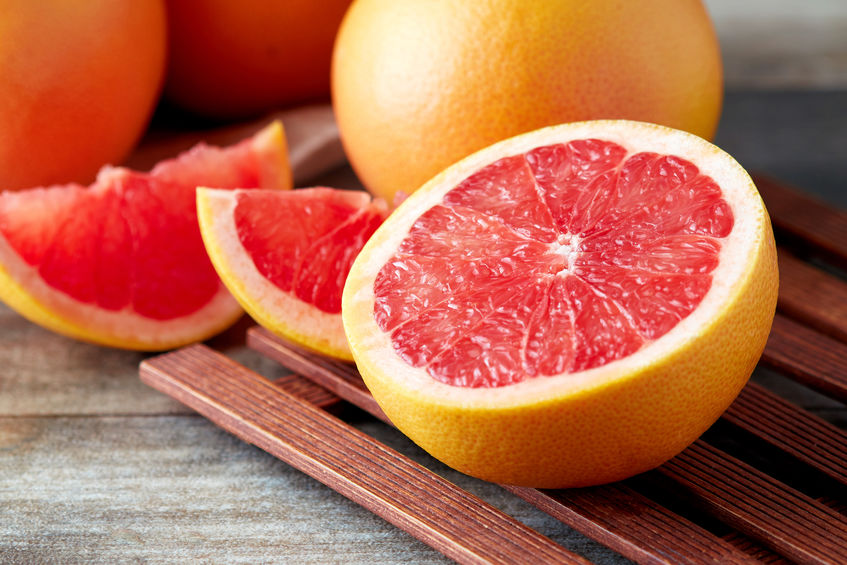By Jessica Scarpati –
Is there another fruit that so bitterly divides fans and foes as the humble grapefruit? Once considered America’s tart sweetheart, grapefruit’s heyday has been on the decline in recent years. But behind the citrus’ complex flavor profile and diet-food reputation is a potent combination of nutrients that pack a punch.
Most notably, grapefruit is a vitamin C powerhouse — with just half a medium pink or red grapefruit containing 100 percent of your daily vitamin C needs. Also known as ascorbic acid, vitamin C is probably best known for its antibacterial and anti-inflammatory properties that protect us from infection, explains registered dietitian Cheryl Mussatto.
“Vitamin C is a well-known friend to your immune system,” Mussatto says. “Vitamin C also helps protect immune cells against harmful compounds coming from viral or bacterial infections. In other words, once those disease-causing germs make their way inside you, vitamin C’s role as an antioxidant is to take action by putting up a barrier preventing the harmful germs attacking the immune cells.”
Grapefruit is also rich in vitamin A in the form of beta-carotene — which aids vision, the immune system and cell growth — with half a medium grapefruit containing 35 percent of the daily recommended intake. Additionally, it’s a respectable source of fiber, potassium and lycopene, a cancer-fighting nutrient that gives pink and red grapefruit their distinctive pigments. And consisting of about 90 percent water, grapefruit is a hydration heavyweight as well.
Numerous studies have tied grapefruit and grapefruit juice consumption to lower risk of type 2 diabetes, heart disease, stroke, kidney stones and cancer. Although it’s most famously associated with weight loss, grapefruit doesn’t contain any special fat-burning properties. That said, the fact that it’s high in fiber, high in water content and low in calories definitely makes it a diet-friendly food, experts say.
Getting the biggest bang for your nutritional buck probably means going red, as red and pink grapefruits seem to boast more benefits than the white variety. A small study in Israel found that heart disease patients who ate either a red or white grapefruit daily saw their cholesterol drop significantly, and those who had red grapefruits experienced a greater reduction.
This sweet-and-sour treat might also just be the fountain of youth.
“Grapefruit is a great example of a fruit that is loaded with skin-protective antioxidants and also has a high water content, which helps keep your skin’s barrier hydrated and more resistant to wrinkle-causing free-radical damage from the sun and daily pollution,” dermatologist Dr. Howard Murad told NewBeauty. “A great benefit of grapefruit is that it promotes the production of collagen, thus making the skin more plump and reducing the appearance of fine lines and wrinkles, keeping the skin looking younger and more supple.”
That’s the good news. Unfortunately, for its many benefits, there’s an equally bitter truth about grapefruit: Consuming it can be dangerous for people taking certain medications for blood pressure, cholesterol or other conditions.
Grapefruit and grapefruit juice can cause your body to absorb too much of some drugs, creating a risk for overdose or other adverse effects, according to the U.S. Food and Drug Administration. Grapefruit is on the no-no list for people who take statins such as Lipitor and Mevacor, blood pressure medications such as Procardia and Cozaar, pain medications such as Oxycodone, erectile dysfunction drugs such as Viagra and Cialis, and many more.
In some cases, grapefruit can have the opposite effect, causing less of the drug to be absorbed and therefore be less effective. One known example of this is fexofenadine, or Allegra, which is used to treat seasonal allergies.
In 2006, scientists at the University of North Carolina identified the culprit behind these dangerous interactions: a group of chemicals called furanocoumarins, or FCs. They found that modifying grapefruit juice to remove all FCs prevented any harmful side effects in people who took 10 mg of the blood pressure drug felodipine with the juice.
Dr. Paul Watkins, whose research team made the discovery, explained in an interview with NBC affiliate WHTR why this finding should give hope to grapefruit groupies who take medications known to interact with the fruit.
“Just as there is lactose-free milk for lactose intolerance, there could be FC-free juice that could be purchased for people who might have a drug-interaction issue but don’t want to give up grapefruit juice,” he said.
More than a decade later, the juice aisle remains unchanged in this regard, but it’s certainly an a-peeling idea.













